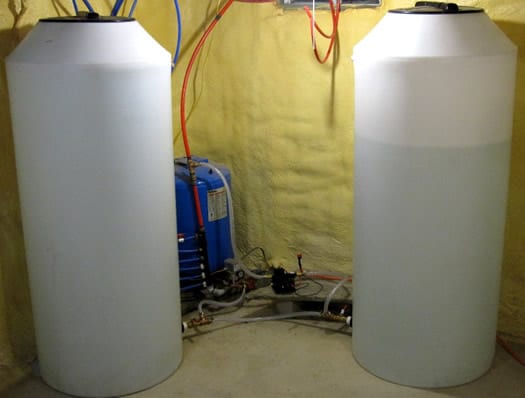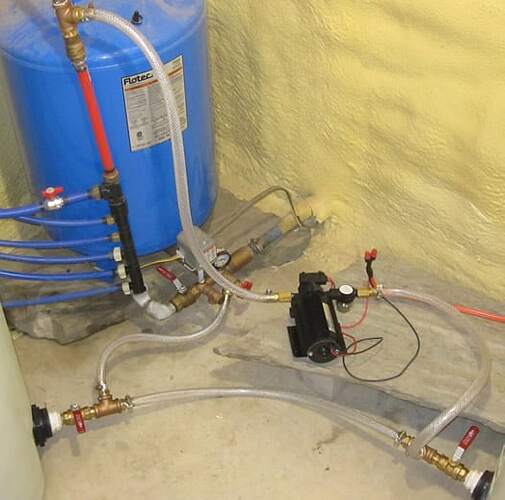On Tuesday, January 12, 2010, the headline "Magnitude 7.0 earthquake shakes Haiti" hit the news. The images of the devastation from this single event (and the aftershocks) were sobering, in the least, and the reccurring theme that impacted me most was the masses of Haitians who were desperate for water.
The basic ingredient of life was being sought after and fought over. Access to clean potable water was now a matter of life and death for so many.
One particular Sunday paper headline and photo shook me for days. I kept this article taped up in my basement as a reminder of why it’s so important to have emergency water available. With it in mind, I decided to design a self-contained system that would allow me to provide water to my family for a minimum of 5 days and many more in a pinch.

I estimated that my family of four used about 80 gallons of water per day during normal everyday usage. This seemed high when I calculated it, but my actual measurements show that about 75 gallons per day is "normal" for my family.
It is a startling amount of water, especially when you consider that the minimum to survive is about 2 gallons per person per day for hydration and basic sanitation (dependent on many factors). We do have low-flow everything and high-efficiency washers, but it all adds up. So 80 gallons per day is our baseline of needs.
I decided that a system that tapped into the existing plumbing would be ideal, as it would allow for easy, quick sanitation and a sense of security during an extended power outage. For simplicity and cost, a plastic FDA-approved tank would be used.
For the capacity that I wanted, one single unit wouldn't fit through my basement door, and I had to go with two smaller tanks. Two tanks would also provide redundancy if any trouble occurred with one. I settled on two 200-gallon tanks from tankdepot.com.
Component 1:
two 200-gallon FDA-approved vertical storage tanks
Subtotal: $339.98
Shipping: $143.28Total: $483.26
When the tanks arrived, I cleaned them out and promptly filled them. The project was put on hold for a few months while other things demanded my attention and dollars (firewood and a decent, used commuter car). While this pause was suboptimal, I rested easy knowing that at least I now had sufficient potable water in my basement.
I endlessly researched the various "surface pumps" that would pump the water out of the holding tanks and into my regular plumbing pressure tank. I considered Dankoff pumps, but their $700 price tag, when you add the required accessories, made me balk. These pumps are very high-end, but interestingly are very susceptible to damage from dry pumping and particulates.
I decided that the Shurflo series pumps were durable, easily repairable, and reasonably priced. I opted for their "Premium 12V" model, which includes their high volume pump and a motor heat sink for allowable continuous use. If doing this project again, I would not spend the extra for the heat sink, as the pump never runs for more than 5 minutes at a time when coupled with a pressure tank.
I also bought a strainer that prevents large debris from getting into the pump.
Component 2:
Shurflo Premium 12V DC surface pump and strainer
Subtotal $180.06
Shipping $16.73Total $196.79
The day the pump arrived via "happy brown truck," I set to work upon getting home. I had done some of the plumbing in advance so that I could do the final work and pressurize the system that night. After working for a couple of hours, I got the system assembled and was able to take a shower without "grid power" (I used my small PV system and inverter to run our on-demand propane heater).
Component 3:
Various 3/4 brass components and nylon hose
Total: $95
Component 1: $483.26
Component 2: $196.79
Component 3: $95.00Total System Cost: $775
The System in Action
Nuts and Bolts:
The pump is at the heart of the system. Its black and red wires are connected to 10-2 wire that runs over to a small PV system, providing it with 12V DC. The hose out of the left of the pump is the pressure side and feeds the house plumbing system. The hose out of the right of the pump is the source side and pulls water from either or both storage tanks depending on the position of each tank's valve.
Currently my approach is to keep one tank full at all times and cycle between the two to ensure fresh water in each tank.
The hose coming out of the left tank and going to the brass manifold under the blue tank is for filling the storage tanks from the well pump. The red, round-handled valve, obscured by a hose, is only opened when the tanks need to be filled.
For normal grid power use, the tanks are closed (as in this picture), the pump is not electrified, and the well pump does its job to pump the water into the pressure tank. In the event of a power outage, or when I just want to exercise the system and cycle the water, I turn off the well pump, open a tank output valve, and turn on the 12V pump. The 12V pump has a built-in check valve (preventing pressure from going back into the holding tanks). The 12V pump also has a built in adjustable pressure switch, which turns the pump on when the pressure drops below the set point.
For the first two days of use, I ran exclusively off tanks in "off grid" mode. There were a couple of glitches when I left a valve in the wrong position, or where before running the 10-2 wire, I had to move the battery back and forth between the PV system and the pump. Except for the grumbling from the basement when the pump ran, there was no other indication that we were using water from storage instead of from the well pump.

Building this water resiliency into my family's lives took a great deal of thought, time, and resources to be fully operational and ready to go, but it has given me much peace of mind to know that we will be covered in times of emergency or extended power outages. The wake-up call of the Haitian disaster really helped focus my efforts, and building this system in stages made the end goal that much more solid and effective.
I hope this summary of my experience gives you inspiration to build your own water storage setup and give your family the resources they need to weather any storms that come their way.
~ Joey Casas
This is a companion discussion topic for the original entry at https://peakprosperity.com/water-storage-an-example-of-resiliency-building-2/
